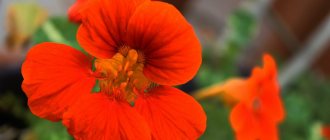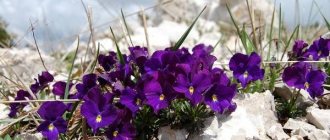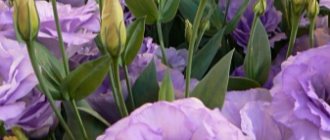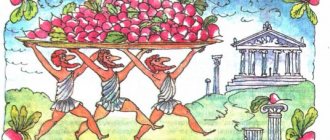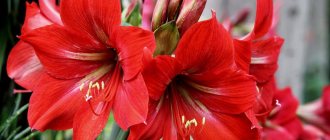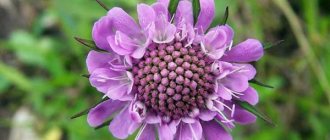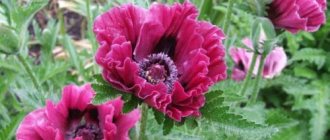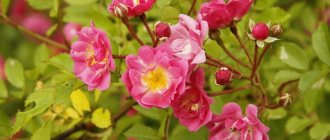What does a climbing nasturtium flower look like?
Nasturtium in the garden
Nasturtium is a flower that begins to bloom in early summer. There are a large number of plant varieties. But climbing nasturtium has common characteristics that distinguish the culture from other varieties.
Which family does it belong to?
Nasturtium flowers belong to the Capuchinaceae (Nasturtium) family. It can be a perennial or annual species depending on the variety. There are more than 80 plant varieties.
Briefly about the history of appearance
Bright flowers look great in any flower bed
The plant was first noticed in South America. Later, varieties of the crop spread to Central America. Gradually, the unusual flower became widespread in various countries, where it was called capuchin.
For reference! The seedling was brought to Russia from Holland. Due to its high ability to take root in any conditions, the plant has become popular.
Plant characteristics
Has the following characteristics:
- the vine forms side shoots, which leads to the weaving of large areas;
- suitable for landscaping gazebos, balconies and fences;
- the roots are located in the top layer of soil;
- buds are large yellow or orange;
- leaves are heart-shaped or small round.
The length of the vine can reach up to 4 meters with proper care. The crop can be grown using seeds or seedlings.
Useful properties of nasturtium
Nasturtium in a flowerbed can act not only as a decoration. The plant has a large number of beneficial properties.
The most famous include:
- bactericidal properties;
- vasodilation;
- anti-inflammatory properties (can be used to remove purulent formations);
- for the treatment of cough;
- treatment of skin for fungal diseases;
- restoration of the heart muscle;
- relief of menopause symptoms in women.
The plant has also gained great popularity in cosmetology. Using the plant extract, you can rejuvenate the skin and improve the condition of the hair.
Important! Nasturtium is not used for diseases of the digestive system. Also, if the juice of the culture gets on the mucous membranes of the eyes, inflammation may occur.
The benefits of nasturtium
Nasturtium leaves and flowers are suitable for consumption. They are added to salads, soups or sandwiches. The plant tastes refreshing and bitter, similar to watercress. Dried flowers are brewed into tea. Pickled fruits are very similar in taste to capers.
In addition, the plant is classified as medicinal. Nasturtium is a natural antibiotic with a large supply of vitamins and microelements. Infusions are drunk for colds and inflammation of the genitourinary system, they are used to rinse hair and wipe the face to treat acne.
Classification of popular types of nasturtiums
Types of ferns and their classification
Varieties of nasturtium have distinctive characteristics and are often used to create unique landscape compositions.
- Nasturtium foreign, or Canarian
A distinctive feature of the culture is the length of the vine, which can reach up to 4 meters. The liana is fleshy with a large number of side shoots.
Climbing nasturtium is used to decorate gazebos and slides. The leaves have a bright green color. A special feature of the plant is its small yellow buds.
Foreign nasturtium
- Large nasturtium
Large nasturtium is distinguished by its large size. Forms a bush that can reach a height of up to 1 meter.
The shoots are fleshy, but weak. The leaves are large green. Large buds can be terry or regular.
- Nasturtium cultivated
A hybrid plant, bushes can reach up to 50 cm in height. The leaves are round and large. Varieties of this variety can be compact in size or used for landscaping gazebos. The shoots are strong, densely decorated with leaves.
- Small nasturtium
Nasturtium minor is a small plant that is often found in gardens. The bush can reach up to 30 cm in height.
The leaves are small, heart-shaped. The buds are small yellow with small dark spots. The flowering period is from early summer until the first frost.
- Nasturtium shieldbearing
A shrub that has long shoots (up to 4 meters). The leaves are densely spaced and dark green in color. The buds are small and red.
Under natural conditions, nasturtium is a perennial plant. However, in many regions of Russia it cannot withstand frost. Therefore, the plant is regularly planted in the spring by using seeds or seedlings.
Important! The varieties of culture described above require undemanding care; they are immune to various types of diseases.
Use in cooking
Nasturtiums are not only decorative. Its flowers, leaves and seeds are edible and are often used in salads (they have a slightly pungent aftertaste).
This plant is also used as an appetizer for meat and other main dishes. Both the young leaves and the flower of nasturtium have an interesting, unconventional taste, very delicate. The flowers are eaten raw or fried. Nasturtium fruits - small seed heads - can be pickled in vinegar; they taste and look like capers.
Because of their rich aroma and slightly spicy taste, the seeds are used instead of horseradish to make tartar sauce, and when you mix the crushed leaves and add nuts or almonds, you get a zesty pesto.
"Capers" from nasturtium
Ingredients:
- nasturtium fruits;
- spices (cloves, herbs, black pepper).
For the marinade:
- ½ cup of wine vinegar (0.1 l);
- 2 cups of water (0.5 l);
- ½ cup sugar (100 g);
- 2 teaspoons salt.
Preparation
- Place green nasturtium fruits in boiling water with a tablespoon of salt, cook for 5 minutes, drain.
- Transfer the fruits into small jars.
- Prepare the marinade: Place water, vinegar, sugar and salt in a large saucepan. Put on fire and stir with a spoon. When the sugar has dissolved and the marinade comes to a boil, remove from heat and pour into jars.
- The jars are sealed and pasteurized in a pan filled with water to 2/3 height for 15 minutes.
Ripe fruits (green only) are harvested in August and September.
Varieties that are most popular with gardeners
Indian chrysanthemum - characteristics of varieties and cultivation from a mixture of seeds
Among the wide variety of plant varieties, it is necessary to highlight the most popular among gardeners.
- Alaska
Nasturtium Alaska is distinguished by a wide variety of bud colors. The height of the bush can reach up to 40 cm. The shoots are well developed with a large number of lateral branches.
Alaska variety
- Maiden Beauty
Nasturtium Maiden's Beauty is distinguished by a variety of colors. The buds are small in size, located on small side shoots.
- Canary
An annual climbing plant, the length of the vines can reach up to 3 meters. Small inflorescences are located on the side shoots.
Blooms bright yellow throughout the summer.
- Vesuvius
The plant grows to a height of no more than 26 cm. The stems are strong, erect, with a large number of lateral branches. The buds are orange in color with burgundy splashes.
Important! In order for the bush to maintain its compact size, it is necessary to timely tie up the shoots.
- Cherry Rose
The height of the plant is no more than 50 cm. The bush grows compactly. The flowers are large cherry color. Most often used to decorate balconies and window boxes.
Cherry Rose variety
- Black truffle
A low-growing crop, the height of which is no more than 30 cm. The leaves are carved green. The inflorescences are dark cherry in color and bloom until the end of October.
- Mahogany
The plant is small with erect shoots. The leaves are round and dark green. Terry buds are bright red.
- Mayskaya
Annual plant. Most often they crawl along the ground. The length of the stem can reach up to 1 meter. The buds are orange in color with bright red stripes.
May nasturtium
- Silk Road
The climbing plant has a thick stem, from which lateral shoots extend in large numbers. Inflorescences of different colors are located on high peduncles.
- Cherry rose
The unusual coloring of the plant makes it popular among gardeners. The height of the bushes is up to 30 cm. The buds are painted in a rich red color.
- Black Lady (Black Velvet)
The plant is distinguished by burgundy buds with yellow spots. The bush can reach a height of more than 40 cm.
- Moonlight
The crop grows in the form of vines reaching a length of up to 3 meters. Small buds are light yellow in color.
Variety Moonlight
- Golden Globe
The bush has the shape of a ball. Often used to create compositions.
The height of the bush can reach up to 40 cm. The leaves are large, shield-shaped. The buds are large, terry, golden in color.
- Gleming Mahagani
The bush is stable, the height can reach up to 40 cm. The inflorescences are densely located on the shoots. The bud is double, red.
- Ladybug
A compact plant, the height of which can reach up to 25 cm. The leaves are small, the branches are underdeveloped. A special feature of the buds is a delicate apricot color with dark spots.
- Salmon Baby
The liana can reach a length of up to 2 meters. Often used to decorate gazebos. Blooms in early summer, retains buds until the first frost. The flowers are salmon-colored.
Variety Salmon Baby
- Peach Melba
Nasturtium is low growing. The height of the bushes can reach up to 30 cm. The shoots are weak and spread along the ground. The leaves are round in shape and rich green in color. The buds can be yellow and orange.
- King Theodore
The height of the bush reaches 40 cm. The leaves are small and green. A distinctive feature is the terry red buds.
Important! The flowers of the plant contain large amounts of vitamin C. Therefore, the buds are often eaten as additions to salads.
Planting and caring for tuberous nasturtium (T. tuberosum)
A herbaceous, climbing plant with shoots three or four meters long and covered with five-fingered small leaves. The funnel-shaped flowers with orange-red or pink sepals open in July and do not diminish in number until October.
Tuberous nasturtium or Mashua has been part of the diet of local populations in Colombia, Ecuador and Peru for thousands of years. However, in Europe it was long known only as an ornamental plant with powerful stems capable of climbing to great heights, anchored on walls by leaf petioles and side shoots.
This type of nasturtium, like in its homeland, in the mountainous regions of the Andes, prefers coolness and plenty of moisture. The length of the glossy, waxy-skinned tubers that form in the soil reaches 20 cm. Moreover, in addition to white, some varieties of nasturtium produce pink, yellow and purple yields of up to 1.5 kg per bush.
All parts of the plant are edible. The tubers can be boiled, frozen, baked or eaten raw. And the leaves and flowers are used in salads and marinades. Planting and caring for this type of nasturtium differs little from growing potatoes. Sowing by seeds is possible, but the best results are obtained by planting seed tubers in spring.
Planting in flowerpots, flowerpots and pots
White peonies - description and characteristics of the best varieties with a colored center
Nasturtium grown in pots
Nasturtium planted in a flowerpot has an unusual appearance and allows you to create hanging compositions.
All types of crops can be used for cultivation. However, the most attractive are the low-growing varieties that do not form long vines.
Planting the crop with seeds is carried out at the end of May. To grow seedlings, seeds must be planted in pots a month before planting. Seedlings should be planted in open ground after the air has warmed up and there is no risk of frost.
Nasturtiums on the balcony are most often planted in box pots. With the help of the plant you can create a bright flower bed on the balcony. For private homes, the ideal solution would be to plant seeds in flowerpots installed along garden paths.
Features of care in the garden and on the balcony
For balconies, terry mixture of nasturtium is most often used. The flowers have bright colors. Care in the garden and on the balcony is no different. In order for the plant to bloom profusely, the following points must be observed:
- It is necessary to water the bushes daily. It is recommended to spray the bushes with water from a spray bottle in the evening.
- Loosen the soil regularly, especially if the plant is grown on a windowsill.
- Remove weeds in a timely manner.
- It is also recommended to remove faded buds and dried branches.
In order for the nasturtium in the pot to bloom profusely, it is recommended to regularly apply nitrogen and potassium fertilizers. For these purposes, ready-made mixtures are used, which must be dissolved in water and the bushes must be fed once a week.
Growing on the balcony
When growing a plant in the garden, a problem often arises when shoots spread along the ground. It is important to know how to tie climbing nasturtium:
- Supports for bushes are installed as soon as the first shoots appear. It is necessary to stretch the wire between the supports.
- After young shoots appear, it is necessary to straighten the vine, forming a beautiful fan.
- To strengthen the vine, you should not use a rope, since the side shoots quickly intertwine with each other, forming a solid canvas.
Often, several plant varieties are used to form such vertical flower beds.
Attention! In order for the flowerbed to bloom profusely throughout the summer, it is recommended to install automatic watering systems.
When and how does it bloom
During the flowering period, the culture attracts everyone's attention. You need to know how nasturtium blooms and what care rules must be followed during the formation of buds.
Flowers consist of 5 or less than 6 petals. Flowers may be double, semi-double or simple. The size of the buds depends on the variety, and can range from 2 to 8 cm in width.
The shape of the flowers is irregular and looks like a hood. At the base of the flower there is a small spur-shaped growth. The original name of the flower was capuchin, which matches the description of the flower.
Flower shape
The period when nasturtium blooms is from mid-June to October. If the seeds are sown at the end of May, the flowering period occurs at the beginning of July.
To extend the flowering period, it is necessary to increase watering before the formation of buds. However, after the first flowers appear, watering stops and is carried out no more than once a week.
The liquid is applied using the root method, so that drops of water do not fall on the buds. It is also necessary to stop fertilizing.
Possible problems in growing
If not cared for correctly, many gardeners wonder why the plant does not bloom. Such symptoms can appear for several reasons.
Pests
Thanks to its bright aroma, the plant is often used in the country to repel pests. However, in rare cases, parasites such as caterpillars may appear on the nasturtium itself. To combat them, it is necessary to pollinate the bushes with wood ash.
Pests of nasturtium
Diseases
Nasturtium has high immunity to diseases. However, in some cases the following problems may occur:
- bacterial wilt;
- spotting;
- gray rot.
When the first signs of the disease appear, the affected area is carefully trimmed.
Important! To prevent the plant from being exposed to diseases, it is necessary to soak the seeds in a light solution of manganese before planting.
Signs of improper care
If not properly cared for, the plant may not form inflorescences. The following factors may be the reasons:
- Use large amounts of water for irrigation. It is necessary to water the plant in small quantities so that the soil is moistened superficially. The accumulation of water leads to the appearance of rot in the root system.
- Use of fertilizers in large quantities. This is especially true for nitrogen-containing substances. Nitrogen provokes the appearance of green mass, but inflorescences will not form. Therefore, it is recommended to alternate different substances during feeding.
- Planting a plant in the shade. Nasturtium prefers sunny places, so planting near buildings and in the shade of trees is not recommended.
Caring for and growing crops in open ground is not difficult if you follow the recommendations of experienced gardeners.
Pest and disease control
Nasturtium is susceptible to fungi and rot, which causes the leaves to turn white and become covered with plaque. All this can be treated well with modern complex fungicides. If the leaves also curl, it is probably due to bacterial wilt, and there is no point in treating it.
Nasturtiums are loved by caterpillars, and their most characteristic feature is holes in the leaves. Bugs, midges and aphids willingly settle on flowers, because this is an effective green manure that takes the blow of pests upon itself. In such cases, use industrial insecticides or ash infusion.
Photo: greensotka.ru
Hydrangea (80 photos): types and features of care
Use in landscape design
Using nasturtium in landscape design
Nasturtium is used to decorate garden plots. It can be planted as an independent plant or as a landscape composition.
Nasturtium is often used to decorate gazebos and airy flower beds. The composition of different varieties of nasturtium against a background of greenery also looks attractive.
Nasturtium is divided into a large number of varieties and subspecies. It can be grown not only in the garden, but also on the balcony. The culture pleases with lush flowering throughout the summer. The plant also has a large number of beneficial properties and can even be eaten fresh.
